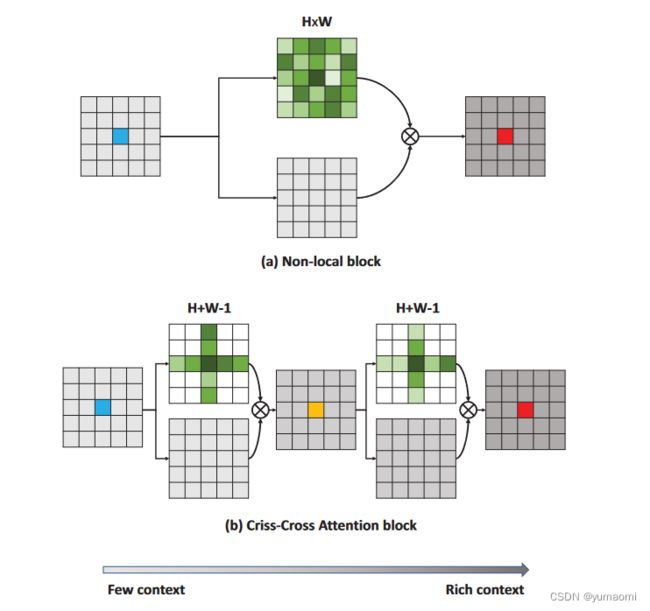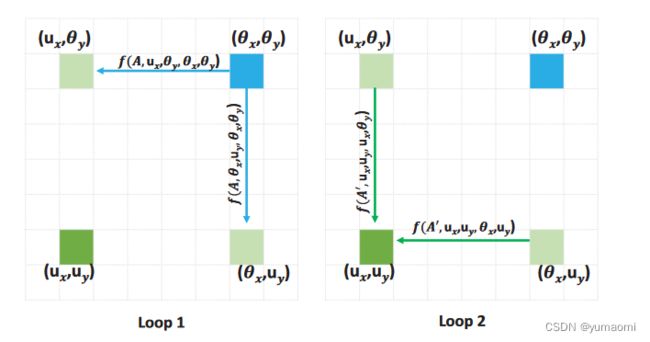语义分割系列20-CCNet(pytorch实现)
CCNet:《Ccnet: Criss-cross attention for semantic segmentation》
本文将介绍CCNet、Criss-cross attention原理、代码实现细节。用时约10分钟。
CCNet发布于2019 ICCV,而Criss-cross attention则是作为Non Local的改进版,主要用于减少Attention机制的计算量。
引文
在以往的语义分割工作中,存在一些大大小小的问题,主要包括感受野问题和计算量问题。
- 为了解决感受野问题,DeepLab一系列工作主要集中在扩张卷积(空洞卷积)上,如DeepLabv2提出的ASPP模块。PSPNet则是提出了PPM模块来处理多尺度的问题,用若干个自适应池化来提取不同尺度上的上下文信息。DANet则是寻求于Attention机制,使用Spatial Attention模块来实现空间注意力机制,建立两个任意位置的空间连接信息。PSANet则是设计了双向的信息流来处理attention maps,使得每一个点信息互相相关。
- Non Local机制或者说是Attention机制,虽然可以很大程度上解决感受野问题,但是在计算复杂度上受限严重。为了减少计算量,最简单的方法就是减小通道数、降低分辨率,但是这些方法会造成信息损失,导致模型结构降低。而EMANet则是通过EM算法来迭代计算Attention maps,通过计算一组基base来更新Attention maps,从而降低计算量。
而CCNet的提出,正是为了解决计算复杂度的问题。
模型细节
Criss-cross attention
为了解决Attention计算复杂的问题,作者提出了Criss-cross attention模块。
图1中包括了None-local(a)和Criss-cross attention(b)的简要示意图,不同于Non-Local一次性计算全图的attention,Criss-cross attention机制则是计算一个点的横纵位置的attention信息。 但是,我们可以猜到,如果只计算一次横纵位置的attention,则其他位置并没有被关联到,也就是这次计算的attention是局限在横纵轴位置上的,其中包括的语义信息并不丰富。为了解决这个问题,作者串行了两个Criss-cross attention模块,这样,对于一个点的位置,首先计算了他的横纵轴的attention,然后将这个信息输出后,再经过一个Criss-cross attention计算,这个点就间接的与全图位置内的任意点进行了计算。如下图2,Loop1中浅绿色方块包含了蓝色方块的内容,Loop2中的深绿色与浅绿色方块进行计算,其中包含了浅绿色+蓝色方块内容,也就是深绿色方块同时关联了浅绿色方块和蓝色方块。
Criss-cross attention实现细节
Criss-cross attention的实现方式还是基于Attention机制,首先,主干网络的输出X经过一个卷积来减少通道数,得到一个feature maps H,H∈ [C×W ×H]。接着H经过三个卷积模块分别生成Q、K和V,其中{Q, K}∈ [C′×W ×H],C′设置为C的八分之一,用于减少计算量。接着,QK通过Affinity操作计算生成A。
对于Affinity操作:在Q中的每一个位置μ,我们都可以在channel轴得到一个向量![]() ,同时我们可以从K中,提取与位置μ处于同一行、列的向量
,同时我们可以从K中,提取与位置μ处于同一行、列的向量![]() ,那么第i个位置的参数就是
,那么第i个位置的参数就是![]() 。对于Affinity计算公式:
。对于Affinity计算公式:
![]()
生成的D经过Softmax激活后,得到A∈ [(H+W −1)×W ×H]。
对于生成的V∈[C×W ×H],我们同样对于每一个位置μ,可以在channel轴上得到一个向量集
![]() ∈[(H+W −1)×C],将这个向量集与生成的A相乘,完成Aggregation操作,最后再加上原始输入H,输出生成的H'。
∈[(H+W −1)×C],将这个向量集与生成的A相乘,完成Aggregation操作,最后再加上原始输入H,输出生成的H'。
![]()
为了使每一个位置μ可以与任何位置对应起来,作者通过两次计算Criss-cross来完成,只需对H'再次计算criss-cross attention,输出H''。此时就有:
![]()
对应于图2的坐标,我们有:
模型结构
模型结构的设计比较简单,因为Criss-Cross attention module如Non Local一样,比较灵活,可以加在任意位置,所以这里作者像其他工作一样,简单的加在CNN的输出后面,用于处理feature maps,通过简单的上采样来完成分割任务。如上文提到,这里叠加了两个Criss-cross attention module,这个叠加的Criss-cross attention,作者称为Recurrent Criss-Cross Attention module。
模型代码
backbone-ResNet50(8倍下采样)
模型选择了ResNet50,并且选择8倍下采样,在其中添加了扩张卷积。
import torch
import torch.nn as nn
class BasicBlock(nn.Module):
expansion: int = 4
def __init__(self, inplanes, planes, stride = 1, downsample = None, groups = 1,
base_width = 64, dilation = 1, norm_layer = None):
super(BasicBlock, self).__init__()
if norm_layer is None:
norm_layer = nn.BatchNorm2d
if groups != 1 or base_width != 64:
raise ValueError("BasicBlock only supports groups=1 and base_width=64")
if dilation > 1:
raise NotImplementedError("Dilation > 1 not supported in BasicBlock")
# Both self.conv1 and self.downsample layers downsample the input when stride != 1
self.conv1 = nn.Conv2d(inplanes, planes ,kernel_size=3, stride=stride,
padding=dilation,groups=groups, bias=False,dilation=dilation)
self.bn1 = norm_layer(planes)
self.relu = nn.ReLU(inplace=True)
self.conv2 = nn.Conv2d(planes, planes ,kernel_size=3, stride=stride,
padding=dilation,groups=groups, bias=False,dilation=dilation)
self.bn2 = norm_layer(planes)
self.downsample = downsample
self.stride = stride
def forward(self, x):
identity = x
out = self.conv1(x)
out = self.bn1(out)
out = self.relu(out)
out = self.conv2(out)
out = self.bn2(out)
if self.downsample is not None:
identity = self.downsample(x)
out += identity
out = self.relu(out)
return out
class Bottleneck(nn.Module):
expansion = 4
def __init__(self, inplanes, planes, stride=1, downsample= None,
groups = 1, base_width = 64, dilation = 1, norm_layer = None,):
super(Bottleneck, self).__init__()
if norm_layer is None:
norm_layer = nn.BatchNorm2d
width = int(planes * (base_width / 64.0)) * groups
# Both self.conv2 and self.downsample layers downsample the input when stride != 1
self.conv1 = nn.Conv2d(inplanes, width, kernel_size=1, stride=1, bias=False)
self.bn1 = norm_layer(width)
self.conv2 = nn.Conv2d(width, width, kernel_size=3, stride=stride, bias=False, padding=dilation, dilation=dilation)
self.bn2 = norm_layer(width)
self.conv3 = nn.Conv2d(width, planes * self.expansion, kernel_size=1, stride=1, bias=False)
self.bn3 = norm_layer(planes * self.expansion)
self.relu = nn.ReLU(inplace=True)
self.downsample = downsample
self.stride = stride
def forward(self, x):
identity = x
out = self.conv1(x)
out = self.bn1(out)
out = self.relu(out)
out = self.conv2(out)
out = self.bn2(out)
out = self.relu(out)
out = self.conv3(out)
out = self.bn3(out)
if self.downsample is not None:
identity = self.downsample(x)
out += identity
out = self.relu(out)
return out
class ResNet(nn.Module):
def __init__(
self,block, layers,num_classes = 1000, zero_init_residual = False, groups = 1,
width_per_group = 64, replace_stride_with_dilation = None, norm_layer = None):
super(ResNet, self).__init__()
if norm_layer is None:
norm_layer = nn.BatchNorm2d
self._norm_layer = norm_layer
self.inplanes = 64
self.dilation = 2
if replace_stride_with_dilation is None:
# each element in the tuple indicates if we should replace
# the 2x2 stride with a dilated convolution instead
replace_stride_with_dilation = [False, False, False]
if len(replace_stride_with_dilation) != 3:
raise ValueError(
"replace_stride_with_dilation should be None "
f"or a 3-element tuple, got {replace_stride_with_dilation}"
)
self.groups = groups
self.base_width = width_per_group
self.conv1 = nn.Conv2d(3, self.inplanes, kernel_size=7, stride=2, padding=3, bias=False)
self.bn1 = norm_layer(self.inplanes)
self.relu = nn.ReLU(inplace=True)
self.maxpool = nn.MaxPool2d(kernel_size=3, stride=2, padding=1)
self.layer1 = self._make_layer(block, 64, layers[0])
self.layer2 = self._make_layer(block, 128, layers[1], stride=1, dilate=replace_stride_with_dilation[0])
self.layer3 = self._make_layer(block, 256, layers[2], stride=2, dilate=replace_stride_with_dilation[1])
self.layer4 = self._make_layer(block, 512, layers[3], stride=1, dilate=replace_stride_with_dilation[2])
self.avgpool = nn.AdaptiveAvgPool2d((1, 1))
self.fc = nn.Linear(512 * block.expansion, num_classes)
for m in self.modules():
if isinstance(m, nn.Conv2d):
nn.init.kaiming_normal_(m.weight, mode="fan_out", nonlinearity="relu")
elif isinstance(m, (nn.BatchNorm2d, nn.GroupNorm)):
nn.init.constant_(m.weight, 1)
nn.init.constant_(m.bias, 0)
# Zero-initialize the last BN in each residual branch,
# so that the residual branch starts with zeros, and each residual block behaves like an identity.
# This improves the model by 0.2~0.3% according to https://arxiv.org/abs/1706.02677
if zero_init_residual:
for m in self.modules():
if isinstance(m, Bottleneck):
nn.init.constant_(m.bn3.weight, 0) # type: ignore[arg-type]
elif isinstance(m, BasicBlock):
nn.init.constant_(m.bn2.weight, 0) # type: ignore[arg-type]
def _make_layer(
self,
block,
planes,
blocks,
stride = 1,
dilate = False,
):
norm_layer = self._norm_layer
downsample = None
previous_dilation = self.dilation
if dilate:
self.dilation *= stride
stride = stride
if stride != 1 or self.inplanes != planes * block.expansion:
downsample = nn.Sequential(
nn.Conv2d(self.inplanes, planes * block.expansion, kernel_size=1, stride=stride, bias=False),
norm_layer(planes * block.expansion))
layers = []
layers.append(
block(
self.inplanes, planes, stride, downsample, self.groups, self.base_width, previous_dilation, norm_layer
)
)
self.inplanes = planes * block.expansion
for _ in range(1, blocks):
layers.append(
block(
self.inplanes,
planes,
groups=self.groups,
base_width=self.base_width,
dilation=self.dilation,
norm_layer=norm_layer,
)
)
return nn.Sequential(*layers)
def _forward_impl(self, x):
out = []
x = self.conv1(x)
x = self.bn1(x)
x = self.relu(x)
x = self.maxpool(x)
x = self.layer1(x)
x = self.layer2(x)
x = self.layer3(x)
x = self.layer4(x)
return x
def forward(self, x) :
return self._forward_impl(x)
def _resnet(block, layers, pretrained_path = None, **kwargs,):
model = ResNet(block, layers, **kwargs)
if pretrained_path is not None:
model.load_state_dict(torch.load(pretrained_path), strict=False)
return model
def resnet50(pretrained_path=None, **kwargs):
return ResNet._resnet(Bottleneck, [3, 4, 6, 3],pretrained_path,**kwargs)
def resnet101(pretrained_path=None, **kwargs):
return ResNet._resnet(Bottleneck, [3, 4, 23, 3],pretrained_path,**kwargs)Criss-Cross attention module
这一部分是CCNet的重点,对于每一个计算步骤的size,我都在上一行中添加了注释。
import torch
import torch.nn as nn
import torch.nn.functional as F
def INF(B,H,W):
return -torch.diag(torch.tensor(float("inf")).cuda().repeat(H),0).unsqueeze(0).repeat(B*W,1,1)
class CrissCrossAttention(nn.Module):
def __init__(self, in_channels):
super(CrissCrossAttention, self).__init__()
self.in_channels = in_channels
self.channels = in_channels // 8
self.ConvQuery = nn.Conv2d(self.in_channels, self.channels, kernel_size=1)
self.ConvKey = nn.Conv2d(self.in_channels, self.channels, kernel_size=1)
self.ConvValue = nn.Conv2d(self.in_channels, self.in_channels, kernel_size=1)
self.SoftMax = nn.Softmax(dim=3)
self.INF = INF
self.gamma = nn.Parameter(torch.zeros(1))
def forward(self, x):
b, _, h, w = x.size()
# [b, c', h, w]
query = self.ConvQuery(x)
# [b, w, c', h] -> [b*w, c', h] -> [b*w, h, c']
query_H = query.permute(0, 3, 1, 2).contiguous().view(b*w, -1, h).permute(0, 2, 1)
# [b, h, c', w] -> [b*h, c', w] -> [b*h, w, c']
query_W = query.permute(0, 2, 1, 3).contiguous().view(b*h, -1, w).permute(0, 2, 1)
# [b, c', h, w]
key = self.ConvKey(x)
# [b, w, c', h] -> [b*w, c', h]
key_H = key.permute(0, 3, 1, 2).contiguous().view(b*w, -1, h)
# [b, h, c', w] -> [b*h, c', w]
key_W = key.permute(0, 2, 1, 3).contiguous().view(b*h, -1, w)
# [b, c, h, w]
value = self.ConvValue(x)
# [b, w, c, h] -> [b*w, c, h]
value_H = value.permute(0, 3, 1, 2).contiguous().view(b*w, -1, h)
# [b, h, c, w] -> [b*h, c, w]
value_W = value.permute(0, 2, 1, 3).contiguous().view(b*h, -1, w)
# [b*w, h, c']* [b*w, c', h] -> [b*w, h, h] -> [b, h, w, h]
energy_H = (torch.bmm(query_H, key_H) + self.INF(b, h, w)).view(b, w, h, h).permute(0, 2, 1, 3)
# [b*h, w, c']*[b*h, c', w] -> [b*h, w, w] -> [b, h, w, w]
energy_W = torch.bmm(query_W, key_W).view(b, h, w, w)
# [b, h, w, h+w] concate channels in axis=3
concate = self.SoftMax(torch.cat([energy_H, energy_W], 3))
# [b, h, w, h] -> [b, w, h, h] -> [b*w, h, h]
attention_H = concate[:,:,:, 0:h].permute(0, 2, 1, 3).contiguous().view(b*w, h, h)
attention_W = concate[:,:,:, h:h+w].contiguous().view(b*h, w, w)
# [b*w, h, c]*[b*w, h, h] -> [b, w, c, h]
out_H = torch.bmm(value_H, attention_H.permute(0, 2, 1)).view(b, w, -1, h).permute(0, 2, 3, 1)
out_W = torch.bmm(value_W, attention_W.permute(0, 2, 1)).view(b, h, -1, w).permute(0, 2, 1, 3)
return self.gamma*(out_H + out_W) + x
if __name__ == "__main__":
model = CrissCrossAttention(512)
x = torch.randn(2, 512, 28, 28)
model.cuda()
out = model(x.cuda())
print(out.shape)
RCCAModule
RCCA Module就是几个Criss-Cross attention module叠加,只需要计算一个循环即可,为了方便,这里还集成了上采用和输出模块。
class RCCAModule(nn.Module):
def __init__(self, recurrence = 2, in_channels = 2048, num_classes=33):
super(RCCAModule, self).__init__()
self.recurrence = recurrence
self.num_classes = num_classes
self.in_channels = in_channels
self.inter_channels = in_channels // 4
self.conv_in = nn.Sequential(
nn.Conv2d(self.in_channels, self.inter_channels, 3, padding=1, bias=False),
nn.BatchNorm2d(self.inter_channels)
)
self.CCA = CrissCrossAttention(self.inter_channels)
self.conv_out = nn.Sequential(
nn.Conv2d(self.inter_channels, self.inter_channels, 3, padding=1, bias=False)
)
self.cls_seg = nn.Sequential(
nn.Conv2d(self.in_channels+self.inter_channels, self.inter_channels, 3, padding=1, bias=False),
nn.BatchNorm2d(self.inter_channels),
nn.Upsample(scale_factor=8, mode="bilinear", align_corners=True),
nn.Conv2d(self.inter_channels, self.num_classes, 1)
)
def forward(self, x):
# reduce channels from C to C' 2048->512
output = self.conv_in(x)
for i in range(self.recurrence):
output = self.CCA(output)
output = self.conv_out(output)
output = self.cls_seg(torch.cat([x, output], 1))
return output
if __name__ == "__main__":
model = RCCAModule(in_channels=2048)
x = torch.randn(2, 2048, 28, 28)
model.cuda()
out = model(x.cuda())
print(out.shape)CCNet
最后集成一下,完成model设置。
class CCNet(nn.Module):
def __init__(self, num_classes):
super(CCNet, self).__init__()
self.backbone = ResNet.resnet50(replace_stride_with_dilation=[1,2,4])
self.decode_head = RCCAModule(recurrence=2, in_channels=2048, num_classes=num_classes)
def forward(self, x):
x = self.backbone(x)
x = self.decode_head(x)
return x
if __name__ == "__main__":
model = CCNet(num_classes=2)
x = torch.randn(2, 3, 224, 224)
model.cuda()
out = model(x.cuda())
print(out.shape)Dataset Camvid
这里在Camvid数据集上进行测试。
# 导入库
import os
os.environ['CUDA_VISIBLE_DEVICES'] = '0'
os.environ["KMP_DUPLICATE_LIB_OK"]="TRUE"
import torch
import torch.nn as nn
import torch.optim as optim
import torch.nn.functional as F
from torch import optim
from torch.utils.data import Dataset, DataLoader, random_split
from tqdm import tqdm
import warnings
warnings.filterwarnings("ignore")
import os.path as osp
import matplotlib.pyplot as plt
from PIL import Image
import numpy as np
import albumentations as A
from albumentations.pytorch.transforms import ToTensorV2
torch.manual_seed(17)
# 自定义数据集CamVidDataset
class CamVidDataset(torch.utils.data.Dataset):
"""CamVid Dataset. Read images, apply augmentation and preprocessing transformations.
Args:
images_dir (str): path to images folder
masks_dir (str): path to segmentation masks folder
class_values (list): values of classes to extract from segmentation mask
augmentation (albumentations.Compose): data transfromation pipeline
(e.g. flip, scale, etc.)
preprocessing (albumentations.Compose): data preprocessing
(e.g. noralization, shape manipulation, etc.)
"""
def __init__(self, images_dir, masks_dir):
self.transform = A.Compose([
A.Resize(224, 224),
A.HorizontalFlip(),
A.VerticalFlip(),
A.Normalize(),
ToTensorV2(),
])
self.ids = os.listdir(images_dir)
self.images_fps = [os.path.join(images_dir, image_id) for image_id in self.ids]
self.masks_fps = [os.path.join(masks_dir, image_id) for image_id in self.ids]
def __getitem__(self, i):
# read data
image = np.array(Image.open(self.images_fps[i]).convert('RGB'))
mask = np.array( Image.open(self.masks_fps[i]).convert('RGB'))
image = self.transform(image=image,mask=mask)
return image['image'], image['mask'][:,:,0]
def __len__(self):
return len(self.ids)
# 设置数据集路径
DATA_DIR = r'database/camvid/camvid/' # 根据自己的路径来设置
x_train_dir = os.path.join(DATA_DIR, 'train_images')
y_train_dir = os.path.join(DATA_DIR, 'train_labels')
x_valid_dir = os.path.join(DATA_DIR, 'valid_images')
y_valid_dir = os.path.join(DATA_DIR, 'valid_labels')
train_dataset = CamVidDataset(
x_train_dir,
y_train_dir,
)
val_dataset = CamVidDataset(
x_valid_dir,
y_valid_dir,
)
train_loader = DataLoader(train_dataset, batch_size=8, shuffle=True,drop_last=True)
val_loader = DataLoader(val_dataset, batch_size=8, shuffle=True,drop_last=True)模型训练
model = CCNet(num_classes=33).cuda()
from d2l import torch as d2l
from tqdm import tqdm
import pandas as pd
#损失函数选用多分类交叉熵损失函数
lossf = nn.CrossEntropyLoss(ignore_index=255)
#选用adam优化器来训练
optimizer = optim.SGD(model.parameters(), lr=0.1)
scheduler = torch.optim.lr_scheduler.StepLR(optimizer, step_size=50, gamma=0.5, last_epoch=-1)
#训练50轮
epochs_num = 100
def train_ch13(net, train_iter, test_iter, loss, trainer, num_epochs,scheduler,
devices=d2l.try_all_gpus()):
timer, num_batches = d2l.Timer(), len(train_iter)
animator = d2l.Animator(xlabel='epoch', xlim=[1, num_epochs], ylim=[0, 1],
legend=['train loss', 'train acc', 'test acc'])
net = nn.DataParallel(net, device_ids=devices).to(devices[0])
loss_list = []
train_acc_list = []
test_acc_list = []
epochs_list = []
time_list = []
for epoch in range(num_epochs):
# Sum of training loss, sum of training accuracy, no. of examples,
# no. of predictions
metric = d2l.Accumulator(4)
for i, (features, labels) in enumerate(train_iter):
timer.start()
l, acc = d2l.train_batch_ch13(
net, features, labels.long(), loss, trainer, devices)
metric.add(l, acc, labels.shape[0], labels.numel())
timer.stop()
if (i + 1) % (num_batches // 5) == 0 or i == num_batches - 1:
animator.add(epoch + (i + 1) / num_batches,
(metric[0] / metric[2], metric[1] / metric[3],
None))
test_acc = d2l.evaluate_accuracy_gpu(net, test_iter)
animator.add(epoch + 1, (None, None, test_acc))
scheduler.step()
print(f"epoch {epoch+1} --- loss {metric[0] / metric[2]:.3f} --- train acc {metric[1] / metric[3]:.3f} --- test acc {test_acc:.3f} --- cost time {timer.sum()}")
#---------保存训练数据---------------
df = pd.DataFrame()
loss_list.append(metric[0] / metric[2])
train_acc_list.append(metric[1] / metric[3])
test_acc_list.append(test_acc)
epochs_list.append(epoch+1)
time_list.append(timer.sum())
df['epoch'] = epochs_list
df['loss'] = loss_list
df['train_acc'] = train_acc_list
df['test_acc'] = test_acc_list
df['time'] = time_list
df.to_excel("savefile/CCNet_camvid.xlsx")
#----------------保存模型-------------------
if np.mod(epoch+1, 5) == 0:
torch.save(model.state_dict(), f'checkpoints/CCNet_{epoch+1}.pth')
train_ch13(model, train_loader, val_loader, lossf, optimizer, epochs_num,scheduler)训练结果



![\large H_u^{''}\leftarrow [f(A,u_x,\theta _y, \theta _x,\theta _y)\cdot f(A',u_x,u_y, u _x,\theta _y) + f(A,\theta_x,u _y, \theta _x,\theta _y)\cdot f(A',u_x,u_y, \theta _x,u _y)] \cdot H_\theta](http://img.e-com-net.com/image/info8/e4cbdf662fd447e69dc9048a0f5e905c.gif)

